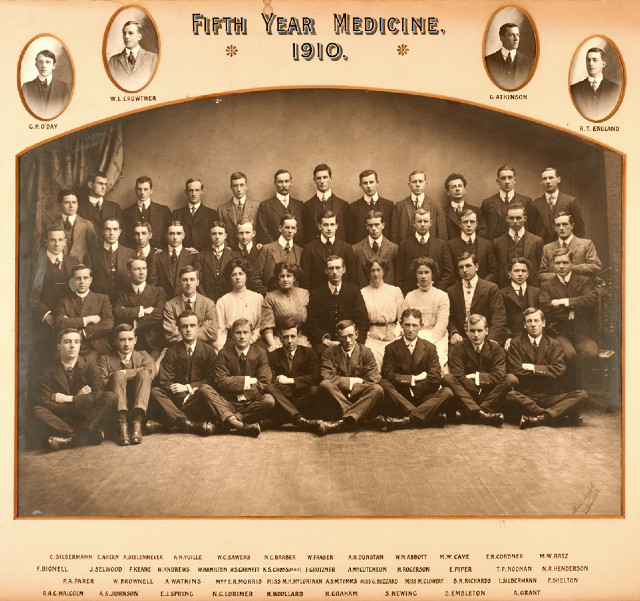Melbourne Medical School celebrated its 150 years in 2012. Established in 1862, Vice Chancellor, AC Brownless, a person of great vision, was determined that the medical program at the University of Melbourne would be a rigorous five year course, with standards higher than equivalent training in any medical school in Britain.

It is impossible to imagine the Melbourne Medical School without its women students, staff and alumni. Women were belatedly admitted to medicine in 1887, 25 years after the establishment of Melbourne Medical School. Yet it was to take another 21 years for women to get the vote in Victoria. The early female students at the University of Melbourne were atthe forefront of social change. When Melbourne Medical School was established in 1862, Vice-Chancellor A.C. Brownless (1817–1897) was determined that the medical program at the University of Melbourne would be a rigorous five-year course, with standards higher than equivalent training in any medical school in Britain. However, Brownless’s view of university education did not extend to the inclusion of women; he actively opposed the motion to admit women to the University of Melbourne in 1879, and to admit women to medicine in 1887. By contrast, the first head of the Medical School, Professor G.B. Halford (1824–1910) recommended as early as 1871, while president of the professorial board, that women who passed the relevant examinations sign the matriculation book.
In 2017, we celebrated the Medical History Museum’s 50th anniversary with the opening of a refurbished museum space, generously funded by Miss Denise de Gruchy in memory of her brother, Professor Carl de Gruchy. The museum now has improved display infrastructure and is more closely integrated with student study spaces, bringing the collection closer to our students.
The museum was established in 1967 through a grant from the Wellcome Trust. Today, it holds more than 13,000 items covering the history of the Melbourne Medical School and the broader history of medicine in Australia and internationally, in a diverse collection of documents, photographs, artefacts, ceremonial objects, and medical and scientific equipment. For 50 years the collection has grown, due to the generosity of benefactors associated with the Melbourne Medical School. Together with alumni, their families and others, these benefactors have been crucial to building this valuable historical and cultural resource. A major donation by the Wellcome Institute was the Savory and Moore pharmacy, shipped out from London in 1971. Other important gifts include the Australian Medical Association Collection of objects and archival material, loaned in 1994 and gifted in 2011 and additions to the pharmaceutical collection from the estates of Graham Roseby and Sir Russell and Lady Grimwade. As well as many major gifts from remarkable researchers and practitioners such as the Crock, Bowman, Barrie Thompson and Saul Weiner collections.
In 2018 there was a major change to our collection policy. Although the museum has successfully placed the history of Melbourne Medical School in the context of settler Australian and international Western medicine, it has not encompassed the traditions of the 65,000 years of healing practice that existed in Australia before the introduction of European medicine. The collections policy was revised to include art and material that relate to Australian Indigenous health care. The emphasis is to collect contemporary art that demonstrates the currency and strength of these healing traditions in communities.
Professor Mark Cook
Chair, Medical History Museum Advisory Committee, University of Melbourne